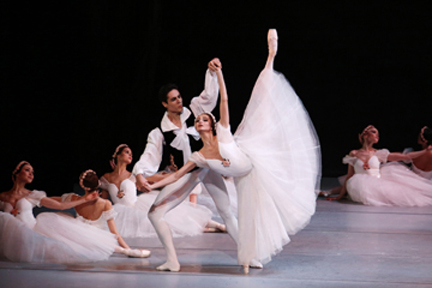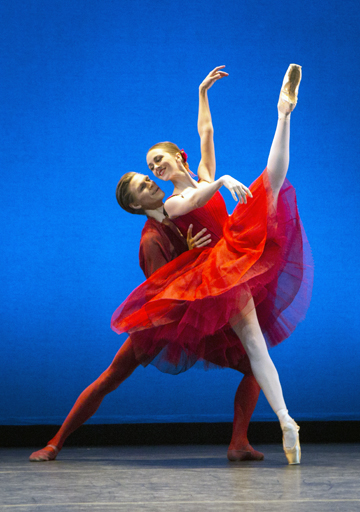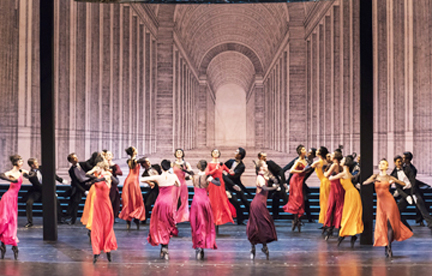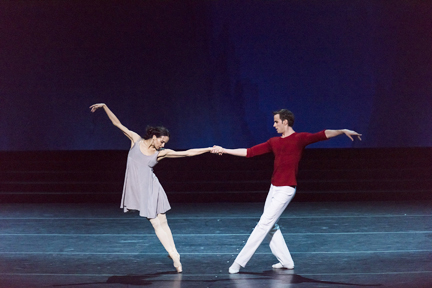Dance: Mixing Tradition and Modern Dance
By Dawn Lille
ART TIMES April 2015 online
Herewith some thoughts on two traditional ballet companies that recently performed in New York and the bonds that connect them: the Royal Danish Ballet and the Mariinsky Ballet.
 Oxana Skorik and Timur Askerovof the Royal Danish Ballet |
The Danes presented a program of excerpts from the ballets of August Bournonville danced by principals and soloists at the Joyce Theater. The company dates back to the 18th century, but it was Bournonville, the son of the French director of the company and the greatest choreographer the Danes produced, who brought the Romantic technique he had studied and danced in Paris back to Denmark. Here, as head of the company, he revised the teaching system and created works that, in their joie de vivre sunniness became a national expression, while their humanity and harmony reached out to all.
Thanks to the Dane’s preservation of his ballets and classes, the world has an exact idea of Romantic ballet. The Bournonville technique, a different class for each day of the week, creates a flexible torso, soft inclining head, flowing arms, unbelievably strong feet and legs and jumps that come from nowhere and soar to the rafters – all in a relaxed and seemingly effortless body. Additionally, the legs do not go above the waistline.
The excerpts, which were costumed, but presented with no scenery and taped music, opened with the Pas de sept from the 1864 ballet A Folk Tale. My first impression was a deep, satisfying breath at the uplifting expression of joy projected by the intricate steps gliding across the stage. At times, there were positions reminiscent of the Degas statue of the young girl with her arms held low behind her back.
 Royal Danish Ballet a Folktale Marcin Kupinski and Kizzy Matiakis dancers |
The Pas de deux from The Flower Festival in Genzano, perhaps Bournonville’s best-known work, exhibited his traditional grace, interconnecting phrasing and the strong role he accorded his male dancers. Ulrik Birkkjaer showed the ballon, the effortless beats of the beautifully pointed feet encased in the Danish male ballet slipper, with its black bottom and white v-shaped top, and the spinning turns that have made these men so sought after.
By the time the closing piece on the program was presented, Act III of the 1842 Napoli, the calling card of the company, the lack of sets, so much a part of Bournonville’s creations, and the sometimes wobbling pitch of the music was distracting. Even the folk elements and the tarantella seemed a bit low- keyed in the performance I saw.
But the biggest disappointment was Act II of La Sylphide. This ballet is one of the two defining works of the Romantic era and Bournonville’s version, which he created soon after his return from Paris as Taglioni’s favorite partner, is the only one we have. When James, the young Scotsman, leaves his pre wedding party, where he has insulted the fortune telling witch Madge and chases after the sylph with whom he is infatuated, we are left with several possible interpretations. He could be seeking the impossible ideal, he could be bi-polar, or, as the program suggests, he is breaking away from his bourgeois world.
Nikolaj Hubbe, the company’s director, has staged a new version of this work. We did not see Act I, but when Madge turns up as a male witch (not unusual in other versions) dressed in a long gray frock coat, demands money for the scarf to capture the sylph and then embraces James in a long kiss, the story line was lost. For other performances Madge was performed by the veteran female dancer Sorella Englund. James, dressed in a semi peasant outfit, did not look bourgeois. Yes, it is sometimes beneficial to bring a traditional work up to date, but only if it is an improvement.
The Mariinsky Theater of St. Petersburg, long associated with classical ballet in the late 19th century, was in residence at BAM, January 14-25. They performed three different ballet programs and one opera with their own full orchestra – all under the direction of the conductor Valery Gergiev. (It is interesting to note that the program listed Mr. Gergiev and the entire orchestra, but not the ballet director or the full ballet company.)
 Mariinsky Theater of St. Petersburg Cinderella |
The performance of Swan Lake will not be considered. The second dance program, Cinderella, choreographed in 2002 by Alexi Ratmansky before he became the most sought after ballet choreographer in the world, was in some ways a contrast, but in others there were ties to the Danes. Ratmansky, Russian born and trained, danced with the Royal Danish Ballet for two years and his work shows the influence of the Romantic arms and articulate feet. In the 1970’s the Mariinsky included both La Sylphide and Napoli in its repertory.
There are many different ballet versions of the Cinderella story based on the fairy tale by Perrault and using Prokofiev’s music, which was commissioned as a ballet score and premiered in 1945. Ratmansky makes the stepmother a bobbed redhead, a cross between a street dancer and a harridan. The stepsisters are not really evil – just awkward, stupid and under their mother’s domination. The father has a brief appearance as an almost catatonic drunkard. Cinderella (Anastasia Matvienko) is young, innocent and searching. The Prince (Alexander Sergeyev), too, is youthful and unsophisticated. They could have been a version of Romeo and Juliet and their melting, beautifully phrased movements reflecting the music kept the eye circling the stage.
The ballroom scene, with the women dressed in long, slinky dresses in shades of burgundy, red and orange, many backless, and the men in black formal attire (except for Cinderella in a soft, white, body skimming dress and the tieless Prince in white) could have been a scene out of The Great Gatsby. The choreography included long lines of shifting, tilting dancers and showed some of Ratmansky’s best relationship to the music, although the punks running in and out were distracting and did not add the touch of modernity they were probably intended to do.
 Mariinsky Theater of St. Petersburg Cinderella . |
Unlike Bournonville and his own later choreography, Ratmansky did not fully establish or develop all his characters. The stepmother was repetitive in her movements and the tramp/godmother was like a pile of rags that remains static. The four seasons who helped Cinderella dress for the ball had no logical place in the narrative as presented and resembled four painted jesters, although Prokofiev did include them in the original libretto. But in all three acts there was much lush, non-academic movement on stage and the dancers seemed so blissfully unaware of their technique that the joy of Bournonville was here as well, if in a less sweet way.
Somebody at either the Mariinsky or BAM decided that a unique program would consist of three works by three different choreographers, all accompanied by Chopin’s music played on a piano. This did give the orchestra time for rehearsals for its Carnegie Hall performance.
Michel Fokine’s Chopiniana, known outside of Russia as Les Sylphides, is regarded as the first abstract ballet of the 20th century. It was originally created in 1907 for a charity performance and had five tableaux, one of which was a waltz for two equal partners, one male and one female that used no virtuosi steps. In 1908 he created his “Second Chopiniana” for a cast of sixteen females and one male, with new orchestrations. He expanded the pas de deux to make an entirely new ballet intended to reveal the poetic side of the Romantic era. The costumes were white ankle length tulle skirts. The movement style, typically Fokine, was soft and lilting, with constantly flowing arms, akin to that of the Danes. Pavlova and Nijinsky danced in this piece.
It was Diaghilev who changed the name when he brought the ballet to Paris in 1909 as part of the repertory of the Ballets Russes, hoping the public would confuse it with La Sylphide and realize its Romantic theme.
The performance by the Mariinsky was plain awful. The soaring movements seemed to stop halfway to nowhere, inclining heads were frozen, the gaze of the women went down into the floor instead of out to space, the arms moved not from the back, but from the elbows, and the noisy pointe shoes drowned out the piano – which was, after all, meant to be an orchestra but, in any case, was lacking in musicality. The blame here is not on the performers but on whoever is coaching them.
Jerome Robbins’ In The Night (1970), for six dancers, was staged by Ben Huys who worked hard to immerse the dancers in the casual quickness and simple seeming speed of entrances and exits in this space devouring work. At times they looked a bit frazzled by this very American work, but they danced beautifully in this piece, which is, like much of Robbins’ work, about relationships.
Benjamin Millepied’s Without (2011) was the other Chopin piece and it left the impression that the choreographer is most familiar with Robbins’ work. It, too, concerned relationships, but they were more on the surface. Although well crafted and danced, it was a bit shallow.
Based on these performance and what others have said about Swan Lake, it would seem that, at the moment, the Mariinsky is more interested in modern works than in traditional ones. The Royal Danish is also undergoing some sort of modernization, but they have not abandoned the style of their traditional works. The secret is to be able to switch from one to the other, with mutual enrichment. Both companies have the dancers. It is a matter of what they dance and who coaches them.
dawnlille@aol.com
